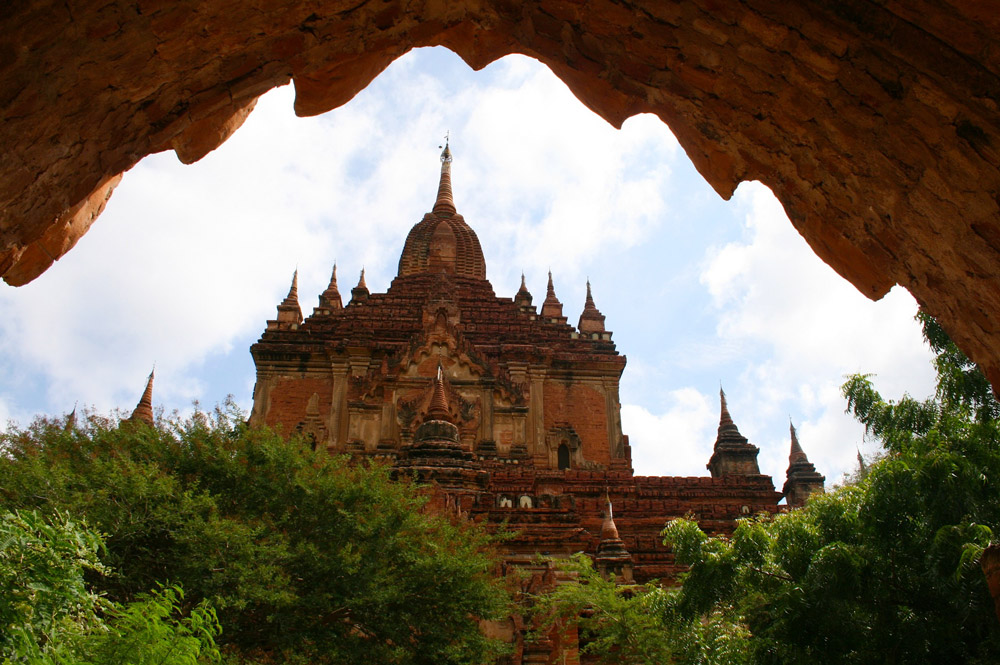An Expert’s Guide to
Temple Hopping in Bagan
Whether you tour Myanmar by land, river cruise, hot air balloon, or trekking on your own two feet, the sites that may linger longest in your mind—not to mention your iPhone—are the temples of Bagan. From the golden domes of stupas to the cone-shaped pagodas with crowning ornamental towers, many of the shrines to Buddhism that you see today date back originally to the 4th century.
So where do you begin temple hopping in a country that once had 10,000 of them? The best place to start is the 26-mile plain of Bagan, also known as the Bagan Archaeological Zone.
Despite wars, invasions, and sackings, the Bagan landscape is dotted with some 2,000 of these ancient, sacred structures. Not surprising this region was and still is one of the most important Buddhist pilgrimage sites in Southeast Asia.
Taking in the Temples of Bagan
If time permits, start with an aerial view of the Bagan plain from  a hot air balloon. It’s well worth the effort to rise early enough to see the magical sun rising over the many golden domes and spires. This drone-like view will give you a sense of the plain’s vastness. Book your balloon ride well in advance. The sky-high ride is extremely popular for Myanmar travelers, despite the cost of nearly $300 or more a person.
a hot air balloon. It’s well worth the effort to rise early enough to see the magical sun rising over the many golden domes and spires. This drone-like view will give you a sense of the plain’s vastness. Book your balloon ride well in advance. The sky-high ride is extremely popular for Myanmar travelers, despite the cost of nearly $300 or more a person.
Next, put on your walking shoes and meander among the stupas, cave temples, and the pagoda towers. Then, to truly appreciate these marvels, choose three for a close-up, longer visit. (We suggest just three temples a day to avoid becoming numb to their beauty.) Take your time, and take it all in.
We’ve narrowed the array of temples to the following six. (If you have only a day, choose three from this list.) Save the best of the remaining 1,994 for future visits to Bagan.
1. Ananda Temple
Built in 1105, Ananda is one of the oldest temples and the largest, measuring 290 feet (a bit shorter than a football field) with pyramid-like terraces that reach 167 feet. Four towering golden Buddhas look out from the central cube in the four opposing directions. Doors of carved teak guard small Buddha statues in niches along the four entrance halls. Wall paintings, stone carvings, and elaborately decorated tiles cover each tier.
2. Kyanzittha Umin
This low, brick temple is built into a stone cliff near Shwesandaw Pagoda. It’s known for its fine frescos and paintings. No doubt some were created by the 12th century monks who lived there, but Mongol invaders in 1287 left their marks, too. You’ll notice paintings of Mongol nobles and warriors along the long, dark corridors. Although Kyanzittha Umin lies both within the cliff and outside, it is representative of Bagan’s characteristic cave temples.
3. Shwesandaw Pagoda

The bell-shaped stupa of sits on five receding terraces and towers 328 feet above the Bagan plain, making it even more imposing than the Shwedagon Pagoda in Yangon.King Anawrahta, founder of the Bagan Kingdom, built the pagoda in 1057. Like most pagodas, this contains a religious relic—a hair of the Buddha—that was a gift to the King. Shwesandaw is sometimes called the Ganesh Pagoda for the stone statues of the Hindu elephant god, Ganesh that once guarded it.
4. Thatbyinnyu Pahto
Built in 1150, the tall spire atop the temple make it the tallest in Bagan. Climb up the three receding terraces 200 feet to see the Bagan plain in all directions. More than 500 depictions of the Jatakas (stories of the Buddha’s life) decorate Thatbyinnyu’s walls; and the intricate, tightly sealed brickwork is a temple hallmark.
5. Htilominlo Pahto
Built in 1218, it marks the spot where King Htilominlo was chosen to be the crown prince. Four large, golden Buddhas are ensconced on the upper floors of the massive 150-foot high structure, and the temple is topped with an ornamental spire from India. Some wall paintings, carved reliefs, and intricate plaster carvings that once covered the brick structure have survived earthquakes. Try to see it again from a distance at sunrise.
6. Gubyaukgyi Temple (Myinkaba)
In nearby Myinkaba is one of several of the region’s cave temples, built in the 12th century, around the time of the Ananda Temple and most others in Bagan. Like Ananda, Indian-style architecture predominates. What’s different, though, are the straight walls that distinguish it from most other monuments. Strategically placed windows light the inner walls and ceiling with sunlight. Many of these windows contain depictions of the Jatakas, stories of the Buddha’s former lives.
Relax—You Earned It!
A leisurely four-day cruise on the Irrawaddy River to Mandalay is the perfect way to wrap up a tour of Myanmar’s temples. Kick back on the Sanctuary Ananda, a custom-built, Burmese-style riverboat with just 21 suites, each with a private balcony, and absolutely delicious food. The bonus—the boat has a spa!
For 113 miles, you’ll revel in views of towns and farmlands, take land excursions that allow you to explore villages, sample the treats at a lively market in Pakokku and take pleasure in the sight of the Ponnyashin Pagoda and sunset on the teak U Bein Bridge.
Explore Myanmar with Myths and Mountains
If the thought of visiting these stunning Bagan temples gets you excited about traveling to Myanmar, let our expert guides help you get the most out of your cultural travel experience. Under the care of our team, traveling to Myanmar is an experience you will never forget. Explore our Myanmar trips and request a more detailed itinerary!

